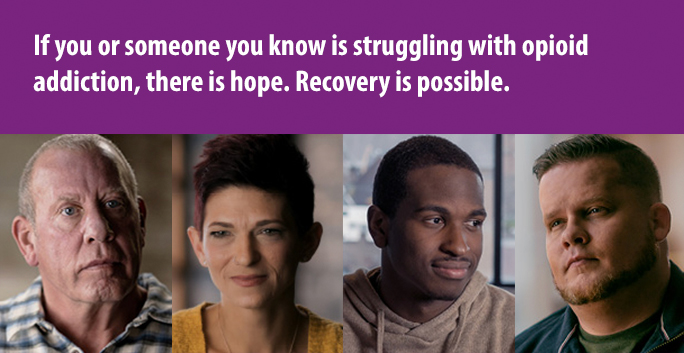Addiction is a disease that reaches people across age, race, gender and income groups. Individuals and families of all shapes and sizes are affected. The Wyoming Department of Health and our partners are taking action to help prevent high rates of opioid abuse and misuse, as well as overdose-related deaths.
What is an opioid?
Opioids can be natural, semi-synthetic or synthetic in origin and generally used to reduce pain. How they are made does not determine legal or illegal use, however.
- Prescription opioids can be prescribed by doctors to treat pain, but can also be obtained illegally. Common examples include oxycodone (OxyContin), hydrocodone (Vicodin), morphine and methadone.
- Fentanyl is many times more powerful than other opioids. It is approved for treating severe pain (typically advanced cancer) when prescribed by doctors. However, it can also be illegally made and distributed, and has been on the rise in the U.S. and Wyoming.
- Heroin is an example of an illegally made opioid from morphine.
Commonly prescribed opioids include:
- Morphine, codeine, methadone, oxycodone (also known as OxyContin®, Percodan®, Percocet®)
- Hydrocodone (also known as Vicodin®, Lortab®, Norco®)
- Hydromorphone (also known as Dilaudid®, Exalgo®)
- Buprenorphine (also known as Subutex®, Suboxone®)
- Fentanyl (also known as Duragesic® or Fentora®) is a synthetic drug many times more powerful than other opioids and is approved to treat severe pain such as from advanced cancer.
Common illicit opioids include:
- Heroin (illegal opioid)
- Fentanyl (a synthetic opioid that is up to 50 times stronger than heroin and 100 times stronger than morphine)
Side effects:
Doctors prescribe opioids for pain, but they can have serious side effects even when taken as directed including:
- Tolerance-over time, you might need to take more for the same pain relief
- Physical dependence-you have withdrawal symptoms when you stop taking the medication
- Increased pain sensitivity
- Constipation
- Nausea, vomiting and dry mouth
- Sleepiness and dizziness
- Confusion
- Depression
- Low testosterone that can result in lower sex drive, energy, and strength
- Itching and sweating
- Overdose leading to death
Opioid Safety
Opioid use, even under a doctor’s supervision, requires constant care and awareness. While they can be used to treat moderate-to-severe pain, it’s important to know opioid prescriptions can also be risky when it comes to addiction.
Anyone who takes prescription opioids can become addicted to them. Side effects of opioids can also be impacted, or made worse, by other prescription medications like benzodiazepines. Benzodiazepines are central nervous system depressants used to sedate, induce sleep, prevent seizures, and relieve anxiety. Examples include alprazolam (Xanax®), diazepam (Valium®), and lorazepam (Ativan®). Avoid taking benzodiazepines while taking prescription opioids whenever possible.
Naloxone is a medicine that rapidly reverses an opioid overdose. It is an opioid antagonist. A common form of Naloxone, NARCAN®, can be purchased at most local pharmacies. NARCAN® 4 mg Nasal Spray is available over-the-counter. In addition, free NARCAN® is now available for agencies, businesses and organizations in Wyoming.
Click here for more resources on overdose prevention.
Recovery is possible!
If you or someone you know is struggling with opioid abuse, there is hope. Recovery is possible.
Mental Health and Substance Use Treatment Services exist to provide statewide leadership of a high-quality mental health and addiction prevention, treatment, and recovery system that is effective.
Regarding current media campaign:
This campaign was supported by funds made available from the Centers for Disease Control and Prevention, Center for State, Tribal, Local and Territorial Support, under 93.391.
The content of advertisements are those of the authors and do not necessarily represent the official position of or endorsement by the Centers for Disease Control and Prevention.





